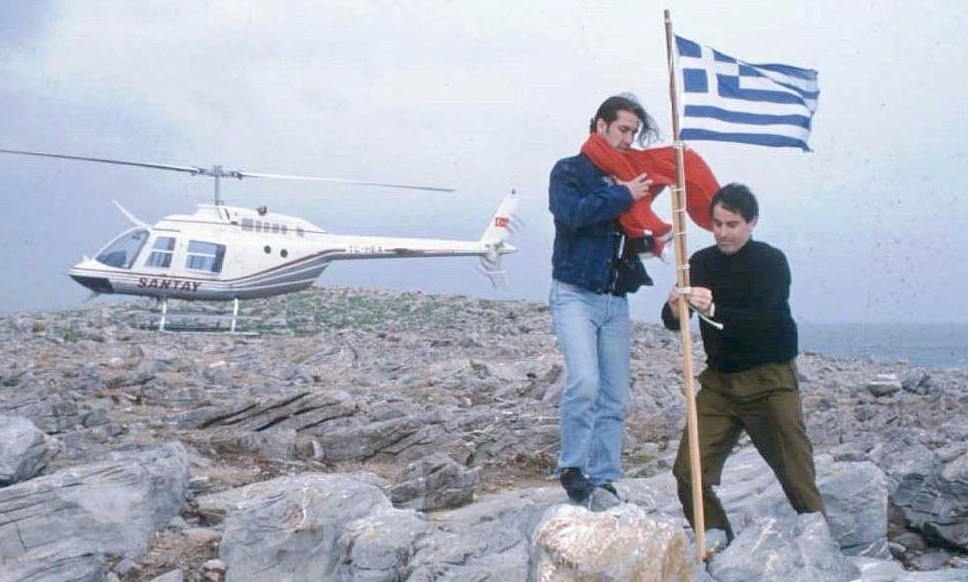In 1996, 25 years ago, Greece and Turkey came heartbeats away from total war over the islets of Imia.
Turkey, despite the legal proof and maps widely available, disputes two small Greek islets even to this day.
While several other aspects of sovereignty rights in the Aegean, such as the territorial waters and national airspace, had been disputed between the two countries for decades, conflicts over the possession of island territory were unknown until the end of 1995.
Turkish hydrographic maps recognised until 1985 the course of the Greek-Turkish border halfway between Imia and the Turkish coast.

In this map, Turkey, whose boundaries are indicated with a dashed line, has itself outlined the border between the Greek islands and the Turkish coast.
Greek islands that have often been referred to by Turkish officials expounding on the “gray zones” theory are depicted by Turkey’s Interior Ministry in this map as Greek.
Among these is the islet cluster of Imia, which is shown within Greek territory, as are the Kastellorizo cluster and many other islands.
With this map, Ankara is in compliance with the international agreements it is a signatory to.
Saying that the dispute over Imia arose when, on 26 December 1995, the Turkish cargo ship Figen Akat, ran aground on one the East islet and had to be salvaged.
A Greek tugboat responded to the distress call.
The Turkish captain initially refused the assistance offered, maintaining that he was within Turkish territorial waters.
He ultimately accepted being towed to the Turkish port of Güllük by the Greek tugboat.
The Greek captain filled in the necessary papers for the salvage fee but the Turkish captain objected, arguing that the freighter had been in Turkish waters.
On 27 December, the Turkish Foreign Ministry notified the Greek authorities that it believed there was a sovereignty issue, and on 29 December it declared the islets were Turkish territory.
On January 9, Athens rejected the claim, citing the Treaty of Lausanne (1923), the Convention between Italy and Turkey (1932) and the Treaty of Paris (1947).
The whole event was barely reported in the media so it was not widely known to public until a month later, on 20 January 1996 when the Greek magazine GRAMMA ran a story.
This was one day after Kostas Simitis was appointed to form a new Greek government as Prime Minister.
The article brought a severe reaction from the Greek press, which was followed by four citizens of the neighboring island of Kalymnos, including the mayor and the owner of a herd of sheep that remained on the islets, hoisting a Greek flag on January 25.
To oppose this, on January 27, some Turkish journalists from Hurriyet landed on the islet with a helicopter, lowered the Greek flag and hoisted a Turkish flag, the whole event being broadcast live on Turkish television.

On January 28, the Greek Navy lowered the Turkish flag and restored the Greek, resulting in an exchange of fierce statements by the Turkish Prime Minister Tansu Çiller and the new Greek Prime Minister Kostas Simitis.
Turkish and Greek naval forces were alerted and warships of both countries, both NATO members, sailed to the islets.
Military crisis
During the crisis, on the night of January 28, Greek special forces landed secretly on the east islet undetected.
On January 30, Greek and Turkish officials gave statements, each insisting on their sovereign rights on Imia.
Also, Turkish armored units moved to the Green Line on Cyprus, which caused alert for the Cypriot National Guard.
On January 31 at 1:40am, Turkish special forces SAT Commandos also landed undetected on the west islet, escalating the tensions.
It was not until 4 hours later when the Greeks noticed this when a Greek helicopter took off at 5:30 am from the Greek frigate Navarino for reconnaissance.
During the mission it crashed over the islets (some speculating due to Turkish fire), but this was concealed by both states to prevent further escalation, although three Greek officers on the helicopter were killed.
They were Christodoulos Karathanasis, Panagiotis Vlahakos, and Ektoras Gialopsos.


